Official Name
Sighetu Marmaţiei, which means "Sighet in Maramureş". The town was formerly known as Sighetul Maramuresului, the Hungarian name Marmaros-Sziget is just a translation of the Romanian name. Locals usually refer to the town simply as Sighet. This means "Fortress".
Location

| ||
| Sighetu Marmaţiei |
Sighet is the northernmost town of Romania and stretches along the border to the →Ukraine. The capital →Bucharest is more than 400 km away. The small river Iza crosses the town before it eventually flows into the long river Tisa (Tisza), which originates in the Ukraine and passes →Hungary and →Serbia before it flows into the river Danube. The town is tucked away in the river valley in the middle of the Wooded Carpathians
Population
Around 40,000. Sighet is the local centre of the area.
Orientation
The train station and the bus terminal are conveniently located next to each other and several hundred metre north of the centre of town. It takes less than 10 minutes to walk from the train station along Str. Iuliu Maniu southwards to get to the centre. There you will find the two roads Str. Traian & Str. Ioan Mihaly de Apşa running parallel to each other. Everything concentrates along these two roads, including some churches, hotels and restaurants. The centre itself is surprisingly beautiful and features several baroque buildings. A small park occupies the narrow stretch between the two streets. Sighet is quite a green town.
Getting there / transportation
Sighet is only two, three kilometres away from the Ukrainian border, but as a matter of fact foreigners are not allowed to cross the border in or near Sighet. Which is really a pity. Unfortunately, the railroad was built during the Habsburg period, which means that two out of three railway lines lead into the →Ukraine. These lines are out of service. The third line leads to →Borşa in the mountains and further to →Cluj-Napoca. If you want to get to the closest big cities, ie Baia Mare and →Satu Mare, you will have to take the bus. To Satu Mare it takes around 125,000 Lei (€ 3), to →Vişeu de Sus 1½ hrs (50,000 Lei).
Sighet is an old market town, which was founded during the 14th. It's the local centre of the northern part of Maramureş, a remote and rather rural area in Romania. Many of the villages around Sighet are unique and reflect Europe as it has already vanished in most areas some hundred years ago. Sighet itself is a small, sleepy town which has somehow managed to keep an atmosphere as of around the year 1900 or so.
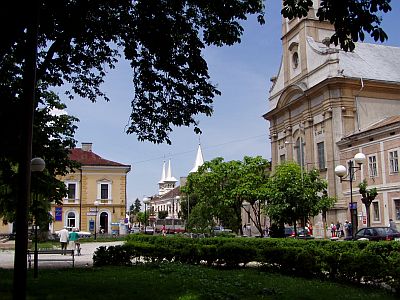
| ||
| The beautiful old town of Sighet |
One thing visitors will soon notice is the large number of churches in the centre of town, among them the Gothic Hungarian Reformed Church built in the 15th century and the slightly younger Romanian Catholic Church. A synagogue and a Jewish cemetary tell the visitor something about the Jewish past of the town. Almost all Jews of Sighet were deported and murdered in extermination camps. Among one of the few survivors was Elie Wiesel, Nobel-prize winner and author of the famous and shocking novel 'Night'.
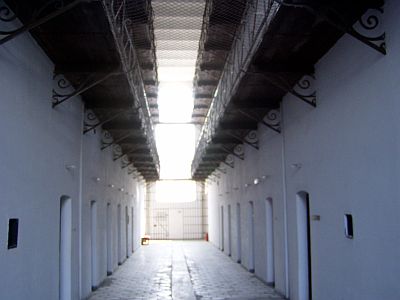
| ||
| Inside the old high security prison |
In the centre of town, on Str. Corneliu Coposu, there's a museum with the long name Muzeu al Gândirii Arestate şi Centru Internaţional de Studii asupra Totalitarismului. It doesn't need profound understanding of the Romanian language to guess what this is about. During the 1950ies, the building was used as a high security prison. The former prime minister as well as many other members of the anticommunist intelligentsia were imprisoned in Sighet and forced to very heavy labour. Many of them did not survive the following years.
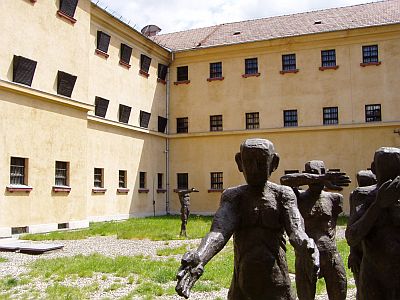
| ||
| Memorial in the courtyard of the prison |
Nowadays, the prison houses a highly interesting museum about the history of suppression of free speech and ethnic minorities as well as about some of Ceauşescu's lunatic projects, eg the Danube canal, mass deportations etc. The cells are used as exhibition rooms, with each room specialising in a specific issue. Unfortunately, very few explanations are in English. Nevertheless it's a very interesting place to visit. There are several impressive monuments in the two courtyards of the large building, among them a group of sculptures. Admission fee for foreigners is 4 Lei, a photo permit costs an extra 3 Lei. The price includes a very short tour through the building (something like "here's the toilet, there's the exhibition, have fun") in English.
Vişeu de Sus
The road from Sighet direction south-east is very scenic. After passing some wooded mountains and old villages, the road enters the valley of the small river Vişeu. Some 75 km away from Sighet, there's the small but very long town of Vişeu de Sus with a traditional wooden church, very typical for this area, in the centre of town. Forestry is the traditional business in the area, and there's a special narrow-gauge railroad from Vişeu to the mountains for bringing down the wood. Occasionally, steam locomotives are still used here. The centre of Vişeu is quite small and green and not particularly interesting - except for the above-mentioned church.
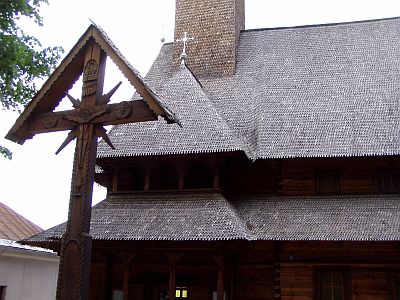
| ||
| The wooden church in the centre of Viseu des Sus |
Borşa
About 20 km away from Vişeu de Sus in the same valley and almost in the mountains, there's the chic holiday resort of Borşa with several large hotel complexes. The small town is located at the foot of the up to 2,300 metres high Rodna Mountains, where snow in late spring is quite a common sight. Borşa and the area around it could be anywhere in the Alps - it looks completely different to other rural areas in the country. When you continue to the south-east, you will get to the →Prislop-Pass, which is the gateway to the historical region Southern Bukovina (lit: country of the beeches), see also →Suceava.

| ||
| Borşa and the Rodna mountains |
In the Southern Bukovina as well as in Maramureş you will notice old villages with partially brand new luxurious villas on the one hand and countless horse carts on the other hand, forming a sharp contrast. Poverty? At first sight, poverty doesn't seem to exist. And when you talk to the people, they don't mention things like that. Most people are very kind and interested towards strangers. Things look very different in the cities. A small restaurant in Sighet was record-breaking (as far as my personal experiences are concerned): Eight beggars in 30 minutes. Half of them were children. Among the others, there was a man presenting a nasty wound on his belly while we were eating.
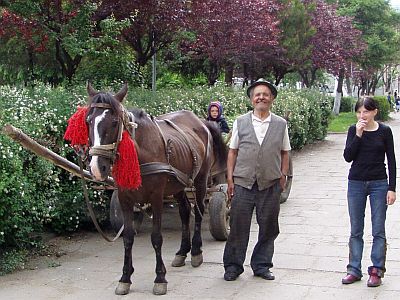
| ||
| Still a common sight: Horse carts. And friendly drivers. |
There aren't many choices - at least not in Sighet, but as far as I've heard in some villages around Sighet. One option is the Hotel Tisa right in the middle of town. It's an old, time-honoured hotel. A double room with balcony and bathroom costs 450,000 Lei (€ 11) per person, including breakfast. Since staff at the hotel tends to forget to tell it to the customers, I should better mention it here: There's no running water at all between midnight and 5 am. Here's the address: Piaţa Libertăţii 8, Tel.: (062)-312 645.
- http://www.johnrausch.com/Maramures Very nice and extensive website about the Maramureş and many of the villages there. Incl. many pictures. English.
- home.t-online.de/home/maramures Interesting website about Sighet and nearby villages. In German.
Do you have or do you know a good website about Sighet? Don't hesitate, let me know! After checking it, I would love to add it to the link list. You can submit a link by using the →contact form. Note that commercial websites will be treated differently.
©2024 Europe-East.com

 Albania
Albania Romania
Romania